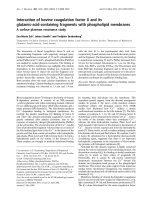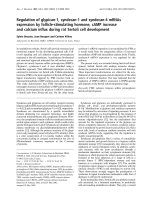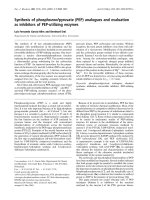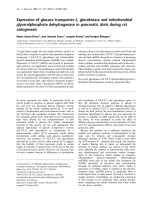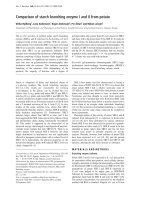Báo cáo y học: "Emergence of physiological rhythmicity in term and preterm neonates in a neonatal intensive care unit"Ơ pdf
Bạn đang xem bản rút gọn của tài liệu. Xem và tải ngay bản đầy đủ của tài liệu tại đây (553.44 KB, 7 trang )
BioMed Central
Page 1 of 7
(page number not for citation purposes)
Journal of Circadian Rhythms
Open Access
Research
Emergence of physiological rhythmicity in term and preterm
neonates in a neonatal intensive care unit
Esmot ara Begum
1
, Motoki Bonno*
1
, Makoto Obata
1
, Hatsumi Yamamoto
1
,
Masatoshi Kawai
2
and Yoshihiro Komada
3
Address:
1
Clinical Research Institute and Department of Pediatrics, National Hospital Organization, Miechuo Medical Center, 2158-5 Hisai
Myojin Cho, Tsu City, Mie 514, Japan,
2
Department of Developmental Clinical Psychology, Institute for Education, Mukogawa Women's
University, 6-46 Ikebiraki Cho, Nishinomiya City, Hyogo 633, Japan and
3
Department of Pediatrics and Developmental Science, Mie University
Graduate School of Medicine, 174-2 Edobashi, Tsu City, Mie 514, Japan
Email: Esmot ara Begum - ; Motoki Bonno* - ; Makoto Obata - ;
Hatsumi Yamamoto - ; Masatoshi Kawai - ; Yoshihiro Komada -
* Corresponding author
Abstract
Background: Biological rhythmicity, particularly circadian rhythmicity, is considered to be a key
mechanism in the maintenance of physiological function. Very little is known, however, about
biological rhythmicity pattern in preterm and term neonates in neonatal intensive care units
(NICU). In this study, we investigated whether term and preterm neonates admitted to NICU
exhibit biological rhythmicity during the neonatal period.
Methods: Twenty-four-hour continuous recording of four physiological variables (heart rate: HR
recorded by electrocardiogram; pulse rate: PR recorded by pulse oxymetry; respiratory rate: RR;
and oxygen saturation of pulse oxymetry: SpO
2
) was conducted on 187 neonates in NICU during
0–21 days of postnatal age (PNA). Rhythmicity was analyzed by spectral analysis (SPSS procedure
Spectra). The Fisher test was performed to test the statistical significance of the cycles. The cycle
with the largest peak of the periodogram intensities was determined as dominant cycle and
confirmed by Fourier analysis. The amplitudes and amplitude indexes for each dominant cycle were
calculated.
Results: Circadian cycles were observed among 23.8% neonates in HR, 20% in PR, 27.8% in RR
and 16% in SpO
2
in 0–3 days of PNA. Percentages of circadian cycles were the highest (40%) at <28
wks of gestational age (GA), decreasing with GA, and the lowest (14.3%) at >= 37 wks GA within
3 days of PNA in PR and were decreased in the later PNA. An increase of the amplitude with GA
was observed in PR, and significant group differences were present in all periods. Amplitudes and
amplitude indexes were positively correlated with postconceptional age (PCA) in PR (p < 0.001).
Among clinical parameters, oxygen administration showed significant association (p < 0.05) with
circadian rhythms of PR in the first 3 days of life.
Conclusion: Whereas circadian rhythmicity in neonates may result from maternal influence, the
increase of amplitude indexes in PR with PCA may be related to physiological maturity. Further
studies are needed to elucidate the effect of oxygenation on physiological rhythmicity in neonates.
Published: 11 September 2006
Journal of Circadian Rhythms 2006, 4:11 doi:10.1186/1740-3391-4-11
Received: 17 May 2006
Accepted: 11 September 2006
This article is available from: />© 2006 ara et al; licensee BioMed Central Ltd.
This is an Open Access article distributed under the terms of the Creative Commons Attribution License ( />),
which permits unrestricted use, distribution, and reproduction in any medium, provided the original work is properly cited.
Journal of Circadian Rhythms 2006, 4:11 />Page 2 of 7
(page number not for citation purposes)
Background
Preterm neonates hospitalized in a neonatal intensive care
unit (NICU) face many challenges to adapt to the new
environment. Heat loss [1], weight loss [2], respiratory
distress and cardiac instability [3] are very common fea-
tures for them. An artificial environment in NICU is man-
datory to support these neonates; however, external
influences such as constant light, noise, and medical inter-
vention may be stressful. Further, neonates are deprived of
maternal influences, which is essential for their develop-
ment. It has been thought that this environmental condi-
tion may influence the development of biological rhythm
in preterm neonates [4-6].
Circadian rhythms are generated endogenously by a bio-
logical clock, which is located in the anterior hypotha-
lamic suprachiasmatic nuclei (SCN) [7,8], and are
modulated by exogenous factors [9,10]. Many physiolog-
ical processes are now known to be cyclically organized
[11]. They show different cycles: circadian cycles last
approximately 24 hours, ultradian cycles shorter than 24
hours, and infradian cycles longer than 24 hours [12].
These rhythms interact mutually as well as with the out-
side fluctuating environment under the control of feed-
back systems providing an orderly function that enables
life [11].
Circadian rhythms have been described in the human
fetus [13-16] and have been attributed either to the mater-
nal environment or to the maturation of the fetal nervous
system [13,17,18]. The SCN has been detected as early as
18–20 weeks of gestational age [19], and primate studies
indicated that the SCN is responsive to light at 24 weeks
of gestational age [20]. In term neonates, circadian
rhythms have been reported to be present immediately
after birth but to eventually disappear [4,21], not being
detected again until 3 to 4 weeks of postnatal life [22].
Some studies showed that circadian rhythms are predom-
inant in preterm neonates [4,21,23], while others showed
ultradian rhythms to be dominant in preterm neonates
[22,24-27]. To elucidate the developmental process of
physiological rhythmicities, we studied four physiological
variables in preterm and term neonates.
Methods
Subjects and data collection
From January 2004 to March 2006, 520 neonates were
admitted to the NICU at Miechuo Medical Center. All of
them were monitored with electrocardiogram (ECG) for
heart rate (HR), respiration rate (RR), and with pulse
oxymetry on the wrist or the feet for saturation of pulse
oxymetry oxygen (SpO
2
) and pulse rate (PR) throughout
their stay in the NICU. Monitored physiological informa-
tion was transformed as measurement variables at 10-sec-
ond intervals by the Wave Achieving System (WAS-J;
Philips Electronics Japan, Tokyo, Japan) through the local
area network in the NICU. The data were recorded for 24
hours for the following postnatal periods: Period 1: days
0–3; Period 2: days 4–6; Period 3: days 7–13; and Period
4: days 14–21. Subjects with continuously disrupted data
for more than 1 minute were excluded from the study. A
total of 187 neonates (114 boys and 73 girls) were
recorded from period 1 to period 4.
The NICU was maintained under a light-dark cycle. The
light was dimmed (less than 30 lux) during the night from
21:00 pm to 07:00 am, while it was maintained at a higher
level (300–580 lux) during the daytime. NICU staff also
varied according to time of day: the number of attendants
at night was one third that of attendants during daytime
hours. Parent's visitations were allowed three times a day
(11:00 to 12:00 in the morning, 14:00 to 15:00 in the
afternoon, and 17:00 to 21:00 in the evening). Bathing
and measurement of body weight were conducted daily in
the morning. Medical examinations, such as blood sam-
pling, radiography, or ultrasonography, were mostly pro-
vided in the morning if necessary.
Written informed consent was obtained from the parents,
and the study was approved by the ethical committee of
the institute. Demographics and health status informa-
tion's were obtained from the medical records.
Analysis of rhythms
Physiological rhythmicity was analyzed for HR, PR, RR
and SpO
2
with spectral analysis (periodogram) with SPSS
11.5 software (SPSS Inc. Chicago, IL), as previously
reported [28]. Briefly, 24 hours sessions were run in 10-
second intervals and were aggregated into 1-minute time
blocks. Periodogram analysis was performed with a time
series of 1440 minutes (N = 1440 observations). The
Fisher test was used to test the statistical significance of the
cyclic components (N = 1440, α = 0.05) [28,29]. Among
the significant cycles, the cycle with the largest peak in the
periodogram was considered to be the dominant cycle for
each time series data and was used for further analysis
[28]. All dominant cycles were confirmed by Fourier anal-
ysis, and further circadian cycles were confirmed by cosi-
nor analysis with a significance of p < 0.05 by least square
analysis (Figure 1). The amplitude, the distance between
mesor and the highest value of the cosine curve, was cal-
culated for each dominant cycle. In addition, an ampli-
tude index was calculated as follows:
Amplitude index = amplitude ÷ mean of variables × 100.
Statistical analysis
Data were analyzed with SPSS and Statview. ANOVA was
used to evaluate the differences between gestational age
groups. The Pearson correlation coefficient was used to
Journal of Circadian Rhythms 2006, 4:11 />Page 3 of 7
(page number not for citation purposes)
analyze the relationships between postconceptional age
(PCA) and rhythmicity parameters. Univariate analysis
using Mann-Whitney U-test for continuous variables or
Fisher's exact test for categorical variables was used to
compare clinical variables according to the development
of physiological rhythmicity. A multiple logistic regres-
sion analysis was performed using a step-wise approach to
determine the independent relationship of significant var-
iables found in the univariate analysis.
Results
Sample characteristics
The demographics of neonates are shown in Table 1. The
median gestational age (GA) was 34 weeks (range: 23–42
weeks), and the median birth weight was 1968 g (range:
454–4132 g). Among these neonates, 9.1% were born at
< 28 weeks of gestation age and 14.4% had birth weight
of less than 1000 g. The median age at hospitalization was
0 day (range: 0–9 day) and the median duration of hospi-
talization was 32 days (range: 5–182 days). One hundred
eleven neonates (59.4%) were intubated and 72 neonates
(38.5%) received oxygen.
Rhythmicity analysis
Results of the analyses of rhythmicity are summarized in
Table 2. To ensure the accuracy of rhythmicity analysis,
parameters missing more than 7% of total data were
excluded from the analysis in each study. Among 461 time
series recorded for each parameters, eligible samples were
obtained in 304 for HR, 379 for PR, 372 for RR, and 383
for SpO
2
within the 4 periods. Among eligible samples,
rhythmicity was observed in more than 90% of neonates
in each period for HR, PR, RR and SpO
2
(Table 2). The per-
centage was not much lower (HR: 89%, PR: 90%, RR:
79%, SpO
2
: 76%) after Bonferroni correction for multiple
testing (p < 0.0001).
Table 1: Demographic characteristics of 187 preterm and term
neonates.
Variables/Categories n (%)
Gender (boys/Girls) 114 (61)/73 (39)
Gestational age (wks), median (range) 34 (23–42)
< 28 17 (9.1)
28–32 49 (26.2)
33–36 58 (31)
≥37 63 (33.7)
Birth Weight (g), median (range) 1968 (454–4132)
< 1000 27 (14.4)
1000–1499 31 (16.6)
1500–1999 38 (20.3)
≥2000 91 (48.7)
Apgar score 1 min/5 min, median (range) 8 (0–10)/9 (2–10)
Age at hospitalization (day), median (range) 0 (0–9)
Hospitalization (day), median (range) 32 (5–182)
Caesarian Section 96 (51.3)
Multiple gestation 4 (2.3)
Intubation 111(59.4)
Oxygenation 72 (38.5)
Birth asphyxia 27 (14.4)
Intrauterine growth retardation 23 (12.3)
Respiratory distress syndrome 31 (16.6)
Transient tachypnea of the newborn 38 (20.3)
Data are expressed as mean ± SD or n (%).
Brief description of steps to determine the dominant cycle using spectral analysisFigure 1
Brief description of steps to determine the dominant
cycle using spectral analysis. A: Plot of original data for
pulse rate (PR). PR was measured once every 10 seconds and
averaged into 1 minute time block for 1440 minutes; N =
1440 observation. B: Periodogram intensities for PR (plotted
on linear scale). The largest peak of the periodogram was
selected (arrow) as representative cyclic component that
represent the largest amount of variance. C: The corre-
sponding cycle of the largest peak in the periodogram intensi-
ties was reconstructed from the FFT coefficient to fit the
sinusoidal function:
χ
t
=
μ
+ Acos(
ω
t) + Bsin(
ω
t). The bold
line is the detected cycle (period: 1440 minutes = 24 hours)
superimposed on the original data.
Journal of Circadian Rhythms 2006, 4:11 />Page 4 of 7
(page number not for citation purposes)
Without correction for multiple testing, circadian cycle
(1440 minutes) was observed among 23.8% neonates in
HR, 20% in PR, 27.8% in RR and 16% in SpO
2
in Period
1. Because many samples were excluded from HR analysis,
and the percentage of eligible samples was consistently
lower than for PR, further analysis of cardiac rhythmicity
used PR instead of HR.
Rhythmicity and gestational age
Rhythmicity was analyzed in four gestational age groups:
< 28 wks, 28–32 wks, 33–36 wks, ≥ 37 wks. The distribu-
tion of circadian cycles in each gestational age groups and
periods is summarized in Table 3. In PR, the percentage of
circadian cycles was highest (40%) at <28 wks of GA,
decreasing with GA, and lowest (14.3%) at ≥ 37 wks of GA
in Period 1. A similar tendency was observed in each
period in PR; however, there was no consistent tendency
in percentages of circadian cycle in RR and SpO
2
.
Amplitudes and amplitude indexes of all detected cycles
in PR in each period are shown in Figure 2. An increase of
circadian amplitude with gestational age was observed in
PR. and significant differences were present among gesta-
tional age groups in all periods (Figure 2A). These changes
were not observed in RR and SpO
2
(data not shown).
Amplitude indexes showed similar tendency to ampli-
tudes in PR (Figure 2B). There were no significant associ-
ations between cycles and amplitudes in any parameter in
each period (data not shown).
Relationship between rhythmicity and postconceptional
age
In examining the relationship with postconceptional age
(PCA), correlation of coefficient was performed using
amplitudes and amplitude indexes in each period for all
parameters. Amplitudes and amplitude indexes of PR
were positively correlated with PCA in all four periods
(Figure 3).
Table 3: Distribution of circadian cycles according to gestational age groups in each period.
Gestational age Period 1 Period 2 Period 3 Period 4
Groups n (0–3 d) n (4–6 d) n (7–13 d) n (14–21 d)
PR <28 wks 10 4 (40) 12 3 (25) 12 5 (41.7) 13 4 (30.8)
28–32 wks 26 6 (23.1) 22 6 (27.3) 42 11 (26.2) 39 9 (23.1)
33–36 wks 29 5 (17.2) 26 5 (19.2) 31 2 (6.5) 23 3 (13.0)
≥37 wks 35 5 (14.3) 27 2 (7.4) 19 2 (10.5) 8 0 (0)
RR < 28 wks 7 1 (14.3) 11 1(9.1) 13 5 (38.5) 13 0 (0)
28–32 wks 24 8 (33.3) 20 9 (45) 38 9 (23.7) 36 8 (22.2)
33–36 wks 25 8 (32) 27 9 (33.3) 28 3 (10.7) 22 2 (9.1)
≥37 wks 34 8 (23.5) 26 9 (34.6) 18 4 (22.2) 8 1(12.5)
SpO2 < 28 wks 10 0 (0) 12 3 (25) 12 3 (25) 13 2 (15.4)
28–32 wks 25 5 (20) 20 3 (15) 40 7 (17.5) 37 9 (24.3)
33–36 wks 26 5 (19.2) 25 5 (20) 32 4 (12.5) 20 3 (15)
≥37 wks 33 5 (15.2) 29 4 (13.8) 19 3 (15.8) 8 1 (12.5)
Data are shown in n (%).
Table 2: Descriptive profiles for significant cycles of HR, PR, RR and SpO
2
.
Period Period 1 Period 2 Period 3 Period 4
Sampling (0–3) (4–6) (7–13) (14–21)
n 116 114 125 106
Eligible sample* HR 82 (70.7) 64 (56.1) 91 (72.8) 67 (63.2)
PR 101 (87.1) 88 (77.2) 106 (84.8) 84 (79.2)
RR 99 (85.3) 85 (74.6) 104 (83.2) 84 (79.2)
SpO2 103 (88.8) 89 (78.1) 106 (84.8) 85 (80.2)
Significant cycle** HR 80 (98) 64 (100) 89 (98) 67 (100)
PR 100 (99) 87 (99) 104 (98.1) 83 (99)
RR 90 (91) 84 (99) 97 (93.3) 79 (94)
SpO2 94 (91.3) 86 (97) 103 (97) 78 (92)
Circadian cycle*** HR 19 (23.8) 11 (17.2) 20 (22.5) 13(19.4)
PR 20 (20) 16 (18.4) 20 (19.2) 16 (19.3)
RR 25 (27.8) 28 (33.3) 21 (21.6) 11 (13.9)
SpO2 15 (16) 10 (11.6) 17 (16.5) 15 (19.2)
Data are shown in n (%). Parentheses are percentages of * eligible samples in all samples, ** significant cycles in all eligible samples, and *** circadian
cycles in significant cycles.
Journal of Circadian Rhythms 2006, 4:11 />Page 5 of 7
(page number not for citation purposes)
Clinical conditions associated with rhythmicity
To determine whether clinical conditions may affect the
emergence and development of rhythmicity, clinical fac-
tors were determined according to cycle length with circa-
dian cycles (1440 minutes) or ultradian cycles (≤ 720
minutes). On univariate analyses in Period 1, circadian
cycle (1440 minutes) was significantly associated (p <
0.05) only with oxygen administration at data sampling
in PR (Table 4), while there were no significant associa-
tions in RR or SpO
2
(data not shown). In Periods 3 and 4
in PR, gestational age was found to be significantly associ-
ated with circadian cycle (p < 0.01) as well as with oxygen
administration (p < 0.05). Neither gestational age nor
oxygen administration qualified as an independent factor
for existence of circadian cycle in multivariate logistic
regression models. Clinical parameters were not associ-
ated with the existence of significant cycles in amplitude
or amplitude index.
Discussion
Rhythmicity has been previously studied in preterm and
term infants for various physiological variables, such as
body temperature [24,30], blood pressure [21], heart rate
[18], sleep-wake pattern [24], rest-activity pattern [26],
melatonin secretion [31], and electroencephalogram [32].
In this study, we have investigated rhythmicity in PR, RR,
and SpO
2
. All of these are important parameters in the
regulation of human physiology, and yet little is known
about rhythmicity of these variables in neonates. We have
shown that most of the analyzed neonates had individual
rhythmicity for these parameters with variable cycles after
birth, even in extremely immature infants.
Linear regression (and coefficients of correlation) for ampli-tudes and amplitude indexes of PR as functions of postcon-ceptional ageFigure 3
Linear regression (and coefficients of correlation) for
amplitudes and amplitude indexes of PR as functions
of postconceptional age. A significant increase in ampli-
tudes and amplitude indexes with postconceptional age is
present in all period in PR.
Amplitudes (A) and amplitude indexes (B) of all detected cycle of PR over the 4 periods for 4 gestational age groups infantsFigure 2
Amplitudes (A) and amplitude indexes (B) of all
detected cycle of PR over the 4 periods for 4 gesta-
tional age groups infants. Data are shown in Mean ± SD.
The dark bar is for < 28 wks, the gray bar is for 28–32 wks,
the light gray bar is for 33–36 wks, and white bar is for ≥ 37
wks. * p < 0.01, ** p < 0.001, *** p < 0.0001, according to
ANOVA. The sample size for each gestational age group is
shown in Table 2.
Journal of Circadian Rhythms 2006, 4:11 />Page 6 of 7
(page number not for citation purposes)
Emergence of circadian rhythmicity has been reported to
be associated with brain maturation of preterm infants
[33,34]. In term neonates, circadian cycles are detected
immediately after birth and subsequently disappear and
are not detectable until 3 to 4 weeks of postnatal life [22].
It has been suggested that circadian cycles in the early neo-
natal period are due to maternal influence in utero and
that endogenous rhythmicity appears only later
[13,17,18]. However, conclusive studies are limited by
subject number because of the difficulty in collecting con-
tinuous data in NICU. Our sample size of 187 neonates is
larger than that of previous studies. As a result, circadian
cycles were confirmed in early neonatal period for all
parameters either in preterm or term neonates. In PR,
comparatively higher percentages of circadian cycles were
observed during early neonatal period in preterm
neonates and persisted through the later neonatal period,
especially in extremely immature infants, while percent-
ages of circadian cycles decreased through the later period
in term neonates. These results partially support the previ-
ous studies [4,21,23]. The fact that environmental condi-
tions were rhythmic in our study (i.e., presence of a light-
dark cycle, of a cycle of NICU staffing, of a cycle of bath-
ing, etc.) prevents us from making inferences about the
endogenous or exogenous nature of biological rhythmic-
ity in our subjects.
Although exact factors for the development of rhythmicity
are still unclear, it has been suggested that physiological
complications may play a role [35]. Among clinical
parameters, disease conditions such as respiratory prob-
lems or asphyxia, and therapeutic drugs such as pheno-
barbital or aminophylline, were not associated with
emergence of circadian cycles. Only oxygen administra-
tion revealed significant association with emergence of
circadian cycles in PR within 3 days of birth. Disruption of
circadian rhythmicity by reduction of oxygen supply, and
restoration by re-oxygenation, has been demonstrated in
rats [36,37]. Reduced oxygen activates hypoxia-inducible
factor 1(HIF-1) [38], which is involved in oxygen home-
ostasis. Chilov and colleagues also indicated that oxygen
supply modulates the circadian clock at the molecular lev-
els via HIF-1 in the mouse brain [39]. Our observations
support these experimental results and suggested that oxy-
gen supply may also influence rhythmicity in humans.
Further analyses are required to explore the influencing
mechanisms on emergence of rhythmicities in neonates.
Conclusion
Preterm neonates are at great risk of life-threatening
events such as infection, respiratory distress or circulatory
failure. As shown in this study, co-existence of circadian
cycles with low amplitude in preterm neonates may com-
plementarily support immature homeostasis and func-
tion against unstable physiological condition. Our results
should aid further research on physiological rhythmicity
in neonates.
Competing interests
The author(s) declare that they have no competing inter-
ests.
Authors' contributions
EB and MB participated in all data collection, in the anal-
ysis and discussion of the results, and in the writing of the
manuscript. MO participated in clinical data collection
and advised on clinical implications of physiological
rhythmicity. HY established the NICU local area network
Table 4: Univariate analysis for association of clinical parameters with existence of circadian rhythmicities in PR in Period 1.
Clinical variables Cycle 1440 (n = 20) ≤ 720 (n = 80) p
Gestational age (wks) 32.7 ± 4.9 34.2 ± 4.6 NS
Birth weight (g) 1930 ± 983 2077 ± 900 NS
Apgar Score < 6 (5 min) 1 (5) 10 (12.7) NS
Asphyxia 4 (20) 17 (21.3) NS
RDS 4 (20) 14 (17.3) NS
IUGR 3 (15) 6 (7.5) NS
Mean of variables
Mean PR (/min) 140.2 ± 8.6 135.5 ± 12.8 NS
Mean RR (/min) 45.7 ± 8.5 43.0 ± 8.5 NS
Mean SpO2 (%) 97.9 ± 1.1 97.9 ± 1.3 NS
Treatment of data sampling
Oxygenation 18 (90) 46 (57.5) 0.02
Intubation 10 (50) 25 (31.3) NS
Aminophylline 1 (5) 4 (5) NS
Phenobarbital 0 (0) 1 (1.3) NS
Midazolam 3 (15) 6 (7.5) NS
Data are expressed as mean ± SD or n (%). Mann-Whitney U test was performed for continuous variables and Fisher's exact test was performed
for categorical variables.
Publish with BioMed Central and every
scientist can read your work free of charge
"BioMed Central will be the most significant development for
disseminating the results of biomedical research in our lifetime."
Sir Paul Nurse, Cancer Research UK
Your research papers will be:
available free of charge to the entire biomedical community
peer reviewed and published immediately upon acceptance
cited in PubMed and archived on PubMed Central
yours — you keep the copyright
Submit your manuscript here:
/>BioMedcentral
Journal of Circadian Rhythms 2006, 4:11 />Page 7 of 7
(page number not for citation purposes)
system (NICU LAN system) for physiological data record-
ing and advised on clinical implications of physiological
rhythmicity. MK provided advice on neonatal physiology
and physiological rhythmicity. YK organized the study
group, obtained grant support, and supervised the writing
of the manuscript. All authors read and approved the final
manuscript.
Acknowledgements
We are grateful to Rebecca M. Warner for her invaluable advice and coop-
eration.
References
1. Hammarlund K, Stromberg B, Sedin G: Heat loss from the skin of
preterm and fullterm newborn infants during the first weeks
after birth. Biol Neonate 1986, 50:1-10.
2. Bauer K, Versmold H: Postnatal weight loss in preterm
neonates less than 1,500 g is due to isotonic dehydration of
the extracellular volume. Acta Paediatr Scand Suppl 1989,
360:37-42.
3. Di Fiore JM, Arko MK, Miller MJ, Krauss A, Betkerur A, Zadell A, Ken-
ney SR, Martin RJ: Cardiorespiratory events in preterm infants
referred for apnea monitoring studies. Pediatrics 2001,
108:1304-1308.
4. Mirmiran M, Kok JH: Circadian rhythms in early human devel-
opment. Early Hum Dev 1991, 26:121-128.
5. Rivkees SA: Developing circadian rhythmicity in infants. Pedi-
atrics 2003, 112:373-381.
6. Mirmiran M, Kok JH, Boer K, Wolf H: Perinatal development of
human circadian rhythms: role of the foetal biological clock.
Neurosci Biobehav Rev 1992, 16:371-378.
7. Panda S, Hogenesch JB, Kay SA: Circadian rhythms from flies to
human. Nature 2002, 417:329-335.
8. Tousson E, Meissl H: Suprachiasmatic nuclei grafts restore the
circadian rhythm in the paraventricular nucleus of the
hypothalamus. J Neurosci 2004, 24:2983-2988.
9. Reppert SM, Weaver DR: Coordination of circadian timing in
mammals. Nature 2002, 418:935-941.
10. Rivkees SA, Mayes L, Jacobs H, Gross I: Rest-activity patterns of
premature infants are regulated by cycled lighting. Pediatrics
2004, 113:833-839.
11. Glass L: Synchronization and rhthmic process in physiology.
Nature 2001, 410:277-284.
12. Lewy H, Naor Z, Ashkenazi IE: From ultradian to infradian
rhythms: LH release patterns in vitro. Chronobiol Int 1999,
16:441-450.
13. Lunshof S, Boer K, Wolf H, van Hoffen G, Bayram N, Mirmiran M:
Fetal and maternal diurnal rhythms during the third trimes-
ter of normal pregnancy: outcomes of computerized analysis
of continuous twenty-four-hour fetal heart rate recordings.
Am J Obstet Gynecol 1998, 178:247-254.
14. Visser GH, Goodman JD, Levine DH, Dawes GS: Diurnal and other
cyclic variations in human fetal heart rate near term. Am J
Obstet Gynecol 1982, 142:535-544.
15. Patrick J: Influence of maternal heart rate and gross fetal
movements on the daily pattern of pattern of fetal heart rate
near term. Am J Obstet Gynecol 1982:533-538.
16. Patrick J, Campbell K, Carmichael L, Natale R, Richardson B: Pat-
terns of gross fetal body movements over 24-hour observa-
tion intervals during the last 10 weeks of pregnancy. Am J
Obstet Gynecol 1982, 142:363-371.
17. Seron-Ferre M, Ducsay CA, Valenzuela GJ: Circadian rhythms
during pregnancy. Endocr Rev 1993, 14:594-609.
18. D'Souza SW, Tenreiro S, Minors D, Chiswick ML, Sims DG, Water-
house J: Skin temperature and heart rate rhythms in infants
of extreme prematurity. Arch Dis Child 1992, 67:784-788.
19. Reppert SM, Weaver DR, Rivkees SA, Stopa EG: Putative mela-
tonin receptors in a human biological clock. Science 1988,
242:78-81.
20. Hao H, Rivkees SA: The biological clock of very premature pri-
mate infants is responsive to light. Proc Natl Acad Sci USA 1999,
96:2426-2429.
21. Dimitriou G, Greenough A, Kavvadia V, Mantagos S: Blood pres-
sure rhythms during the perinatal period in very immature,
extremely low birthweight neonates. Early Hum Dev 1999,
56:49-56.
22. Ardura J, Andres J, Aldana J, Revilla MA, Aragon MP: Heart rate bio-
rhythm changes during the first three months of life. Biol
Neonate 1997, 72:94-101.
23. Updike PA, Accurso FJ, Jones RH: Physiologic circadian rhyth-
micity in preterm infants. Nurs Res 1985, 34:160-163.
24. Bueno C, Diambra L, Menna-Barreto L: Sleep-Wake and Temper-
ature Rhythms in Preterm Babies Maintained in a Neonatal
Care Unit.
Sleep Research Online 2001, 4(3):77-82.
25. Schimmel M, Waterhouse J, Marques MD, Weinert D: Circadian
and Ultradian Rhythmicities in very premature neonates
Maintained in Incubators. Biol Rhythm Res 2002, 33:83-112.
26. Korte J, Wulff K, Oppe C, Siegmund R: Ultradian and circadian
activity-rest rhythms of preterm neonates compared to full-
term neonates using actigraphic monitoring. Chronobiol Int
2001, 18:697-708.
27. Weinert D, Sitka U, Minors DS, Waterhouse JM: The development
of circadian rhythmicity in neonates. Early Hum Dev 1994,
36:117-126.
28. Warner RM: Spectral Analysis of Time-series Data The Goldford Press,
New York, London; 1998.
29. Russell RJ: Significance table for the result of fast fourier trans-
formations. British Journal of Mathematical and Statistical Psychology
1985, 38:116-119.
30. Thomas KA: The emergence of body temperature biorhythm
in preterm infants. Nurs Res 1991, 40:98-102.
31. Ardura J, Gutierrez R, Andres J, Agapito T: Emergence and evolu-
tion of the circadian rhythm of melatonin in children. Horm
Res 2003, 59:66-72.
32. Wakayama K, Ogawa T, Goto K, Sonoda H: Development of ultra-
dian rhythm of EEG activities in premature babies. early
Human Development 1993, 32:11-30.
33. Mirmiran M, Bernardo L, Jenkins SL, Ma XH, Brenna JT, Nathanielsz
PW: Growth, neurobehavioral and circadian rhythm devel-
opment in newborn baboons. Pediatr Res 2001, 49:673-677.
34. Mirmiran M, Baldwin RB, Boeddiker M, Ariagno RL: Development
of circadian rhythms in premature infants. Sleep Research
Online 1999, 2(Supplement 1):.
35. Thomas KA: Biological rhythm development in preterm
infants: does health status influence body temperature circa-
dian rhythm?
Res Nurs Health 2001, 24:170-180.
36. Mortola JP, Seifert EL: Hypoxic depression of circadian rhythms
in adult rats. J Appl Physiol 2000, 88:365-368.
37. Bishop B, Silva G, Krasney J, Salloum A, Roberts A, Nakano H, Shu-
card D, Rifkin D, Farkas G: Circadian rhythms of body temper-
ature and activity levels during 63 h of hypoxia in the rat. Am
J Physiol Regul Integr Comp Physiol 2000, 279:R1378-R1385.
38. Sharp FR, Bernaudin M: HIF1 and oxygen sensing in the brain.
Nat Rev Neurosci 2004, 5:437-448.
39. Chilov D, Hofer T, Bauer C, Wenger RH, Gassmann M: Hypoxia
affects expression of circadian genes PER1 and CLOCK in
mouse brain. Faseb J 2001, 15:2613-2622.


